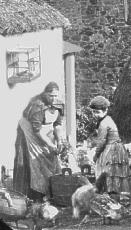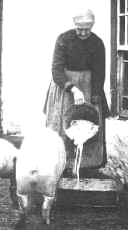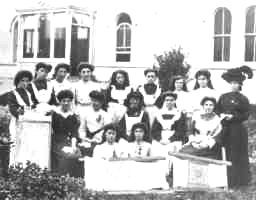
Feeding the fowl

Feeding the pigs
In the early 1930s, Conrad Arensberg and Solon T. Kimball conducted a detailed sociological survey of a small rural area in Co. Clare. In the course of their study of family life, they detailed the activities of a woman's day in winter when farm work was slack.
The woman was first to rise at 7.30 a.m. She rekindled the fire, prepared the breakfast and served it to her husband and sons, waiting to eat until they were finished. She dressed and fed the children, got them off to school, made beds, washed up, swept the floors and washed clothes.
Then she took the buckets and milked the cows. She separated the milk and made butter. She fed the calves from a bucket and boiled large pots of potatoes for chickens and pigs.
She cooked the midday meal, usually boiled potatoes, bacon and cabbage. The men sat down to eat and she stood by ready to refill their plates. 'As before, the women and children do not eat until the men have finished.'
She washed up and prepared to feed calves, chickens and pigs again as in the morning. Turf had to be brought in from the shed, water from the well and mending and knitting were constant chores. She baked bread on a griddle on the open hearth, often twice a day.
Children came home from school and men from the fields. Men's work was finished for the day, but the woman's work went on. She prepared, served and cleaned up after the tea and then went to milk the cows in the sheds and separate the milk. She might help the children with their lessons and put them to bed. If she joined the men at the open fire, she brought her knitting or mending.
Men's work was valued more than women's and men doing women's work met with ridicule. Arensberg and Kimball observed in Clare,
| That a man should concern himself with a woman's work, such as the sale of eggs or the making of butter, is the subject of derisive laughter, ... There is no formal taboo confining a woman to women's work. Heavy work is merely felt to be a hardship upon her. Conrad Arensberg and Solon T. Kimball, Family & community in Ireland, Harvard, 1968, p.48. |
Men generally controlled the sale of animals and crops. Women traditionally contributed to the household income - or earned 'pin money' for themselves - by feeding pigs and poultry and by making butter.
 Feeding the fowl |
 Feeding the pigs |
Both photographs reproduced with the kind permission of the
Museums & Galleries of Northern Ireland
They could make a major contribution in the north and west of the country by spinning and weaving but these economic opportunities for women collapsed during the later modern period:
· spinning and weaving were industrialised in the nineteenth century
· creameries took over the making of butter towards the end of the nineteenth century
· rearing pigs and poultry became industrialised in the mid twentieth century.
With less income-producing work to do, standards of housekeeping rose to fill the space and courses in cookery and needlework were provided in every district in the 1890s.
| The Congested Districts Board, the Department of Agriculture and Technical Instruction and the Irish Agricultural Organisation Society all instituted education in housewifery. One by one, their classes in lace-making, knitting, poultry and butter-making were converted into domestic education classes. Women supported this move and attended in ever-increasing numbers. Joanna Bourke in Irish economic and social history, XVIII (1991), p.41. |

Lace class, Castletownbere. Early 20th century
Béara's pictorial past
Women's work in the west of Ireland could be harder, due to seasonal migration of labourers (spailpíní and tattie hokers) to England and Scotland in peak agricultural seasons. In many cases the men tilled and planted the crops in spring and then migrated until autumn while the women and children remained to garden, manure, weed, mow, harvest crops and save the turf as well as caring for their families.
Martin Forkan from Kiltimagh, Co. Mayo told how in his father's time in the nineteenth century the women,
| '... done all the work after the husband went away to England, in the line of looking after turf and looking after crops and everything. They had to do all that and they used to rear pigs and hens and that's how most of us kept going.' Quoted in Anne O'Dowd, Spalpeens and tattie hokers, Dublin, 1991, p.172. |
Photographs show women hauling heavy loads of vegetables, turf and wet seaweed. Women worked in ports gutting, cleaning and shelling fish. In mining areas, they worked occasionally as miners, more often at surface work sorting or breaking up the ore.